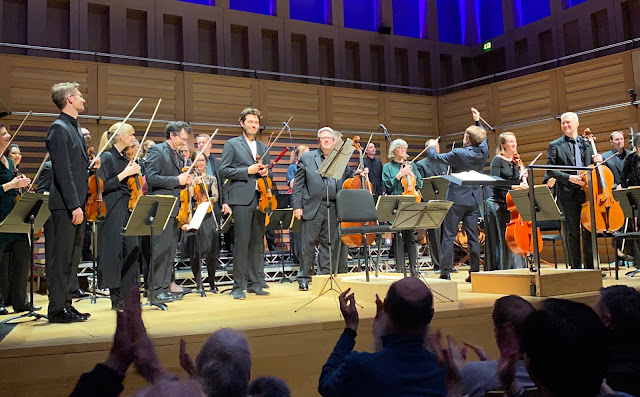 |
| Lawrence Power, Paul Watkins, Simon Crawford-Phillips, Västerås Sinfonietta at Kings Place (Photo Maestro Arts) |
Reviewed by Robert Hugill on 19 February 2020 Star rating: (★★★★)
A programme brimming with energy and enthusiasm from this Swedish chamber orchestra, including a gutsy rendition of Brahms' late concerto
The Västerås Sinfonietta and its chief conductor, Simon Crawford-Phillips, blew into town on Sunday (Storm Dennis not withstanding) for a short tour of the UK, with concerts in Bristol and Southampton, ending at Kings Place on 19 February 2020 as part of the Nature Unwrapped season. Under the title Wild Waves & Woods the orchestra gave us Mendelssohn's The Hebrides Overture, Andrea Tarrodi's Zephyros, Gyorgyi Ligeti's Concert Romanesc, Antonin Dvorak's Silent Woods and Johannes Brahms' Concerto for violin and cello in A minor, Op. 102 with Lawrence Power (violin) and Paul Watkins (cello).
Västerås is city in Sweden some 100 kilometres or so West of Stockholm, and the Västerås Sinfonietta is based at the Västerås Konserthus where it gives regular subscription seasons. Founded in 1883, it is one of Sweden's oldest orchestras. Simon Crawford-Phillips has been artistic advisor and chief conductor since 2017.
The orchestra is a chamber ensemble, at Kings Place there were some 21 strings, a full complement of woodwind (including four horns for the Brahms), two trumpets and percussion, which led to a very full platform indeed, even though they played standing up.
Not surprisingly, the sound in Kings Place's Hall One had a vivid presence and throughout the concert the orchestra made a strong, gutsy sound. This was an evening full of energy and strong colours. And whatever the music, the players really put themselves into it. In Mendelssohn's The Hebrides Overture the music was vividly descriptive, we really felt the tang of the salt spray, rather than the misty romanticism which this music usually engenders. And I really liked the balance, with just 21 strings giving us a strong, lithe string line, we could hear a lot more of the woodwind detail which is a great benefit. Crawford-Phillips drew real dynamic thrust and impetus from his players.
Andrea Tarrodi is a young Swedish composer (born 1981) and her piece Zephyros was written in 2010 and inspired by a poem by the Swedish poet and author Dan Andersson (1888-1920) about a storm passing through. It opened with rather evocative French-inspired textures of flutes over shimmering strings, and then the music gradually built as the storm came, and then passed through. Textures were in constant motion, with multiple layers of interest, so that the music seemed to change colour from bar to bar, almost note to note.
The final work in the first half was Gyorgy Ligeti's Concert Romanesc, written whilst he was still living in Hungary. The short, four-movement concerto for orchestra evokes the folk-music of the Romanian-speaking region of Transylvania where Ligeti grew up, vivid, almost anarchic and full of striking rhythms. Ligeti's early training included ethnomusical research so though the tunes are all his, the atmosphere is pure folk. After a gently lyrical first movement with characteristically uneven rhythms in the melodies, there was a vivid, fast dance. The slow movement featured the horns evoking the sound of alphorns from across the valley, something Ligeti remembered from his youth. The finale was vivid with excitement as the orchestra really played with gutsy energy.
Before the Brahms, there was another short solo work. Cellist Paul Watkins played the solo in Dvorak's Silent Woods, a version for solo cello and small orchestra (reduced woodwind) of a piece for piano duet. Essentially a gorgeous long breathed cello solo, with a more urgent middle section, all beautifully sung by Watkins.
Watkins was then joined on the platform by Lawrence Power, best known as a viola player but here, rather intriguingly, playing the violin in Brahms' final orchestral work. It was written as a present for the great violinist Joseph Joachim (with whom Brahms had fallen out over Joachim's marital problems), but the fact that Robert Haussman, the cellist in Joachim's quartet and the dedicatee of Brahms' Cello Sonata No. 2, had asked the composer for a cello concerto had something to do with it too. The resulting concerto betrays Brahms' interest in Baroque concerto grosso form, and there are plenty of moments where the two soloists are first amongst equals rather than being the dominant factor in the piece. That the two solo parts spend most of the work in dialogue also contributes to the work's distinctive atmosphere.
The first movement opened robustly, with the two soloists entering with a strong, impulsive dialogue. The gutsy orchestral sound was complemented by the excitement of the solo players, Power and Watkins had a relationship where sparks did fly, both have a strong presences and there was a vividness to their interaction. And even in the relaxed moments, playing by both soloists and orchestra had an urgency to it. The lovely slow movement was one of those moments when Power, Watkins, Crawford-Phillips and the orchestra really did evoke the concerto grosso rather than having the solo duo over spotlit, and this contrasted with the more urgent middle section. The perky finale featured lively interactions between the soloists, culminating in a wonderfully rumbustious dance.
We have come to understand that many of Brahms' orchestral works were played in his lifetime by orchestral forces rather smaller than the full line up of the Vienna Philharmonic. Whilst this performance might have lacked the surface polish and sophistication brought by a luxurious string department, the commitment and energy of the playing along with the sheer vividness of the sound brought out the rustic and folk elements in Brahms' make-up.
There were two encores, first Power and Watkins played a charming early duo by Sibelius, Raindrops, all pizzicato. Then the orchestra gave us the overture to Mozart's opera The Magic Flute, played from memory, with the players all mixed up and largely conductorless. Terrific.




.webp)


.jpg)



No comments:
Post a Comment